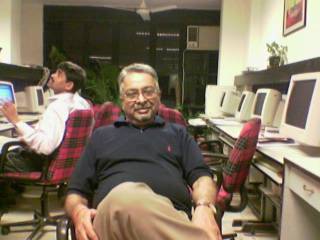
I don’t know about you, but I love wall posters. In fact, I grew up loving them from the deep of my heart. Environment has a lot to do with this fascination. It was late 1960s and early 1970s before I packed up and left “Singara Chennai” (Beautiful Chennai) in search of bread and butter. My neighbor was a wall poster contractor: Kanakasabai. He had a crew that handled film and political posters. Remember, am talking about the Kollywood and the tinsel town that sent a matinee idol – late M G Ramachandran – to sit in the hot seat of Fort St. George to determine the fate of millions of Tamils in the state of Tamilnadu. Also remember it is the state that built a temple – yes, a temple - for Bollywood reject, but Kollywood hottie Khushboo.
Posters meant giant ones. Empty walls were a rarity because everything used to be plastered with posters: either about the newly released Tamil flick, or a Tamil drama (TV was more than a decade away!) to be staged at the local sabha (halls) or a political meeting or a religious discourse (kathakalakshebham) by eminent scholars at Venus Colony mostly. Or Tirupathi temple’s Celestial Umbrella passing through the Chennai which when happens used to draw a lot of conservative Tamil women mostly to pray and offer money into the hundi. All these need to be told to the potential audience well in audience. Well, that’s where posters used to play a crucial role. That’s what Kanasaby did for a living mostly.
Another reason for my poster fixation was honestly that is where I practiced my English learning. I used to translate Tamil movie names into English equivalent. For instance, “Eastbound Train” for the Bharati Raja blockbuster “Kizhakke Pogum Rail” (this was made in Hindi with Sunny Deol in “Saware Wali Gaddi” later); “Wealth or Family?” for “Panama Paasama?” – another Love king late Gemini Ganesan (Bollywood thespian Rekha’s father). “Truth will Triumph” for “Dharmam Thalai Kakkum”, an MGR flick. Well, the list is endless.
Besides the posters, I used to cherish the aroma of the paste itself. Cooked in hot tins on a kerbside brick-stacked impromptu ovens with dry wood as fuel. The poster boys (not the ones featured, but those who paste the posters on walls across the city) – mostly post midnight and before dawn. These lean boys, with stacks of posters bundled and kept in the rear seat holder and a tin of gluey paste hung on the handle bar, used to cycle round the neighbourhood – say a radius of 10 km maximum – plastering empty walls with their merchandise. My wonderment used to about the way they wear their long shorts and over and above them a tucked in multi-coloured lungi revealing their shorts. It is a solo act because between midnight and daybreak they have to complete their “assignment” and return home. But as they leave on their mission, their bonhomie is seen to be believed.
As I cycle around the next morning, I used to see the posters these chaps have carried out and make a mental connect with them. On occasions, buffalos or cows would eat up the posters, attracted by the wet paste. Well, there were also occasions when political posters would display a handful of cowdung on the face of the personality – as a mark of disrespect or cunningness attempted his rivals. This used to happen to leading male matinee idols posters as well: MGR fans would disfigure Sivaji Ganesan’s posters and vice versa. Or at times, just the face would be torn off giving a ghastly feel.
Passing through Mangalore and watching film posters and hoardings adorning the walls pushed me back to the jolly 1960s. Though I cannot read any of these posters, I still could relate to them. Any day, I would vote for these paper posters over neon signs atop buildings. They serve a purpose: to propagate an idea or promote a film or personality. Besides a whole lot of job opportunity for the unskilled and or uneducated brethren. If the walls get disfigured in the process, so be it. Maybe someone is trying to translate the Kannada film titles like I did four or five decades ago. Thank God, this form of propagation has not died!
Tailpiece
 The wall poster culture has gone to the masses in the neighbouring Tamilnadu, it seems. Saw this poster at Namakkal recently. The gent shown in this wall poster has died a year ago and his friends are observing his first death anniversary. On enquiry with the local populace, learnt that he is an ordinary folk – not a politico.
The wall poster culture has gone to the masses in the neighbouring Tamilnadu, it seems. Saw this poster at Namakkal recently. The gent shown in this wall poster has died a year ago and his friends are observing his first death anniversary. On enquiry with the local populace, learnt that he is an ordinary folk – not a politico.



